Or as I’ve nick-named it- “The Tryon Project”,
after it’s creator, Mr. Richard Tryon.
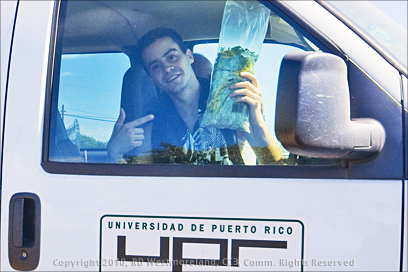 I had the great privilege of meeting Mr. Tryon and his wife where he gave me (and me 1st Mate) the big tour and back-story of his Santa Isabel pilot project.
I had the great privilege of meeting Mr. Tryon and his wife where he gave me (and me 1st Mate) the big tour and back-story of his Santa Isabel pilot project.
We got there just as a van full of college students were leaving. That’s not Recao, but Cilantro he’s holding up. Very polite dude, BTW.
This article is somewhat of a departure from my usual travel material, but I like it because it shows off some of the more interesting projects being done in Puerto Rico. Especially any effort to help create self-suffecient, self-relient individuals like me-self… ARRG! I also thought Puerto Ricans on the mainland would be interested in this as well. So here’s what I got.
 The Back Story- Like everything I’ve stumbled on to in PR, the old hacienda has a ‘sordid past’. Way back when, it was a popular lounge for US military from Fort Allen and Camp Santiago on a weekend pass. The stage for the band still stands in the corner. Cold beer ‘n Rum flowed freely and Hostesses worked the the GI’s the moment they hit the grounds. It was the ‘hot spot’ back then. Those days are long gone.
The Back Story- Like everything I’ve stumbled on to in PR, the old hacienda has a ‘sordid past’. Way back when, it was a popular lounge for US military from Fort Allen and Camp Santiago on a weekend pass. The stage for the band still stands in the corner. Cold beer ‘n Rum flowed freely and Hostesses worked the the GI’s the moment they hit the grounds. It was the ‘hot spot’ back then. Those days are long gone.
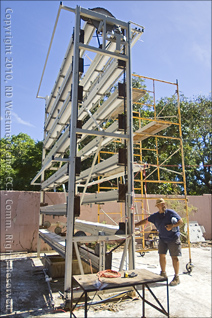
The Tryon Project:
The Eco-Farm project is basically a self-sustaining, closed loop concept capitalizing on Hydroponics, Aquaculture, Self-sufficient Energy production and locally grown structural components, i.e. Bamboo. Tying them together in a logical, low cost, low tech manner. 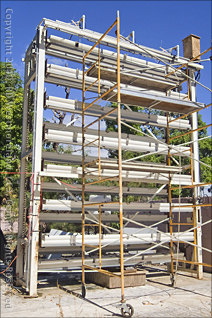 That’s not to say there is no tech here. There is plenty of tech in the concept and installation of the ‘Eco Farm’, but the actual operation of the eco-farm is relatively simple. A 4th element to the project makes use of Bamboo grown in close proximity. The final element covers collection, distribution and sales.
That’s not to say there is no tech here. There is plenty of tech in the concept and installation of the ‘Eco Farm’, but the actual operation of the eco-farm is relatively simple. A 4th element to the project makes use of Bamboo grown in close proximity. The final element covers collection, distribution and sales.
Details.. It’s all in the Details
I’ll break out some specifics regarding the components and how they tie together.
Basically, hydroponics is growing plants in water, without using soil. This works as long as the water contains all the nutrients necessary for plant growth. Roots also need some aeration, but that can be done via the water or by alternately allowing the roots some time, free from water. Almost any vegetable or fruit can be grown this way. Furthermore, by stacking the plant trays in a tower conserves real estate. If you have ever seen rolls of carpet on a chain driven warehouse rack, you get the idea. 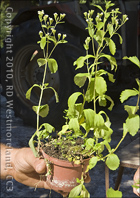 In this application, water is fed to the top tray allowing gravity to drive it downward. When it gets to the bottom, a spill valve discharges the water so the tray can travel up the opposite side. This allows for the aeration of the root system (as mentioned earlier) before it reaches the top again. There is an additional hydraulic system that serves as a governor to prevent the rack of trays from cycling too quickly. Another tremendous advantage to this system is it’s adaptability- It can quickly and easily switch over to a different crop based on what the market is doing. A good example of that would be ‘Stevia’. A plant that’s in high demand as a sugar substitute and can be used raw or passed on for refining into a sugar-like substance. It grows quite rapidly under the Puerto Rican sun. Or grow off-season produce at a premium price since stuff grows here year round.
In this application, water is fed to the top tray allowing gravity to drive it downward. When it gets to the bottom, a spill valve discharges the water so the tray can travel up the opposite side. This allows for the aeration of the root system (as mentioned earlier) before it reaches the top again. There is an additional hydraulic system that serves as a governor to prevent the rack of trays from cycling too quickly. Another tremendous advantage to this system is it’s adaptability- It can quickly and easily switch over to a different crop based on what the market is doing. A good example of that would be ‘Stevia’. A plant that’s in high demand as a sugar substitute and can be used raw or passed on for refining into a sugar-like substance. It grows quite rapidly under the Puerto Rican sun. Or grow off-season produce at a premium price since stuff grows here year round. 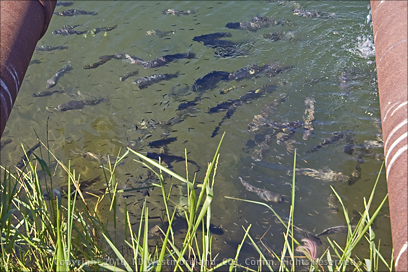 The individual Hydroponic trays are small enough to be handled by young adults. All work is done at waist-level minimizing back issues. A real problem for most farm workers. Nutrients for the Hydroponics comes from the Aquaculture part of the operation.
The individual Hydroponic trays are small enough to be handled by young adults. All work is done at waist-level minimizing back issues. A real problem for most farm workers. Nutrients for the Hydroponics comes from the Aquaculture part of the operation.
Aquaculture-
Most folks are familiar with farmed fish. In this application, Mr Tryon is using Tilapia and for good reason. Often referred to as “Aquatic Chicken”, it’s readily available in the Western world so most folks are familiar with it (I’ve tried it, Tilapia is quite tasty).  Its a freshwater fish that has been farmed in China, the East and Africa for centuries. Tilapia is very easy to grow in captivity… it grows to size quickly, reproduces in quantity, tolerates high stock density, is very resistant to disease and parasite infection and is mostly a plant eater.
Its a freshwater fish that has been farmed in China, the East and Africa for centuries. Tilapia is very easy to grow in captivity… it grows to size quickly, reproduces in quantity, tolerates high stock density, is very resistant to disease and parasite infection and is mostly a plant eater. 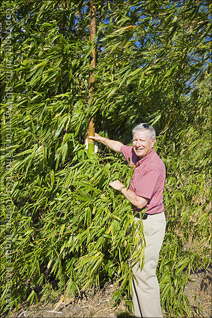 Fry have been added to rice paddies and were mature enough to eat by harvest time (5″-6″ long) . Tilapia have been used to control algae and mosquito populations as well. Unlike Salmon, the presence of heavy-metals is almost nonexistent. Tilapia is high protein, low in saturated fats, low calorie, low in carbohydrates and low in sodium.
Fry have been added to rice paddies and were mature enough to eat by harvest time (5″-6″ long) . Tilapia have been used to control algae and mosquito populations as well. Unlike Salmon, the presence of heavy-metals is almost nonexistent. Tilapia is high protein, low in saturated fats, low calorie, low in carbohydrates and low in sodium. 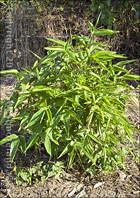 The flesh is high in several key elements- Phosphorus, Niacin, Selenium, vitamin B-12 and Potassium. It also makes a good fertilizer too. Who Knew? The only issues with Tilapia are- it will not tolerate temps below 60F (not a problem in PR) and can contain Omega-6 fatty acids (like hamburger) depending on what they were fed. Also not an issue with this plan. The water circulated for aeration is used to provide nutrients for the Hydroponics.
The flesh is high in several key elements- Phosphorus, Niacin, Selenium, vitamin B-12 and Potassium. It also makes a good fertilizer too. Who Knew? The only issues with Tilapia are- it will not tolerate temps below 60F (not a problem in PR) and can contain Omega-6 fatty acids (like hamburger) depending on what they were fed. Also not an issue with this plan. The water circulated for aeration is used to provide nutrients for the Hydroponics.
Power Needs-
By now you can see the need for pumping water around to the various elements, aerating water for the fish and providing for the farmer’s own power needs. 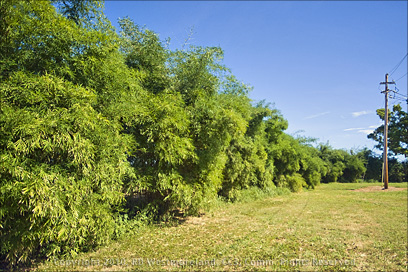 This can be easily done with readily available small scale wind generators and a couple of solar panels charging a small bank of batteries, then distributed via an inverter. Me and the 1st Mate had discussed doing something like that, ourselves. Santa Isabel is down by the coast so there is a ready supply of wind and sun. The batteries will help cover inclement weather which hardly ever lasts more than a few days. This can be set up to operate completely free of the local utility grid.
This can be easily done with readily available small scale wind generators and a couple of solar panels charging a small bank of batteries, then distributed via an inverter. Me and the 1st Mate had discussed doing something like that, ourselves. Santa Isabel is down by the coast so there is a ready supply of wind and sun. The batteries will help cover inclement weather which hardly ever lasts more than a few days. This can be set up to operate completely free of the local utility grid.
Construction Needs-
Bamboo will be used for the construction of pretty much everything but the Vertical Hydroponic Towers. The three varieties of Bamboo on Mr. Tryon’s property are coming along quite nicely. The Bamboo shoot (small vertical shot), Guadua Angustafolia is about 4″ in diameter at the base and about 2 feet tall. 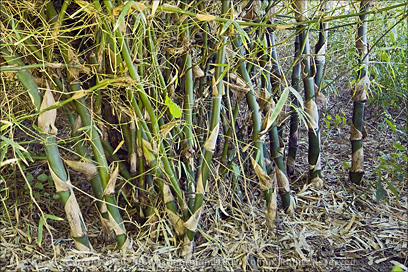 For a sense of scale, Mr. Tryon is standing in front of another group of G. Angustafolia, all of which was planted 23 months back. The shoot he is touching is now over twice his height. It is an extremely dense Bamboo and used for heavy construction applications. The wind break with power pole and closeup of culm clumps is Dendrocalmus Strictus. Also good for general construction applications and one I’m particularly interested in. The 3rd and newest member is a very hearty Aculenta Agustafolia that can grow to 100 feet. Right now, it resembles a bush, but has much broader leaves than the other two. Mr. Tryon consulted with the folks at the USDA-ARS Tropical Ag. Research Station in Mayaguez as well as Sadhu Govardham of Govardham Gardens, regarding what Bamboo to get and grow. I’ve mentioned Mr. Govardham in a past article. Yet another PR farm and nursery I plan to visit in the future.
For a sense of scale, Mr. Tryon is standing in front of another group of G. Angustafolia, all of which was planted 23 months back. The shoot he is touching is now over twice his height. It is an extremely dense Bamboo and used for heavy construction applications. The wind break with power pole and closeup of culm clumps is Dendrocalmus Strictus. Also good for general construction applications and one I’m particularly interested in. The 3rd and newest member is a very hearty Aculenta Agustafolia that can grow to 100 feet. Right now, it resembles a bush, but has much broader leaves than the other two. Mr. Tryon consulted with the folks at the USDA-ARS Tropical Ag. Research Station in Mayaguez as well as Sadhu Govardham of Govardham Gardens, regarding what Bamboo to get and grow. I’ve mentioned Mr. Govardham in a past article. Yet another PR farm and nursery I plan to visit in the future.
Produce Collection, Distribution and Sales-
This element is still in development, but is envisioned as a water-driven sluiceway to move the produce from the small farms to a central collective. Something that would make heavy use of Bamboo construction. Sales would most likely be done through a co-op type entity with an Internet component. More details about this in a future installment.
Though this project is still in it’s prototype phase, it has lots of potential. An awful lot of time and money has been spent to get it to this point. Mr. Tryon has a very clear picture of what he’s got in mind. You can preview a slide show outlining his effort by going to the Tryon Technologies Web site. I look forward to following his progress and reporting on it from time to time.
Much of my research was taken from Wikipedia. A great source.

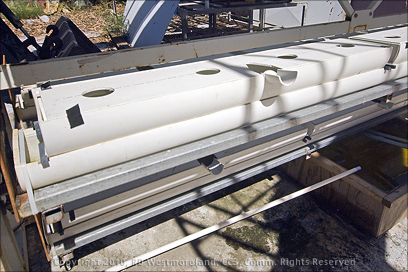

Javier Fernandez says
Amazing! Thanks Robert for keeping us informed of all the beautiful things that you find in Puerto Rico. God Bless you and your Mate! Saludos from Ohio Javier Fernandez (S.Dog-Thanks! Arrg!)
Mark says
I like how you guys are doing this in such a sustainable way. Your idea is quite the inspiration for something I’d like to do in the future. I will follow your updates.
Irvin Carrero says
Great post, love the idea.